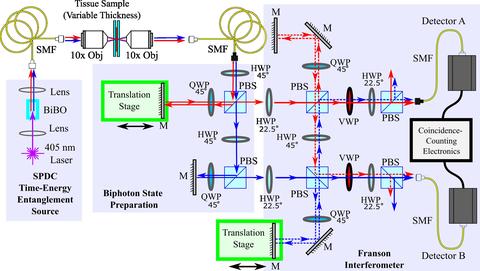Summary
The Biosystems and Biomaterials Division (BBD) is developing tools to take advantage of the quantum nature of light, enabling new biological measurements as well as enhancing existing optical modalities. BBD was the first to demonstrate that so-called time-energy entangled photons can propagate through millimeters of biological media and still maintain their entangled nature, which bolsters much fundamental physics demonstrations of advantages of using entangled light sources for enhanced measurement capabilities. Currently, we are developing unique imaging platforms using entangled photon pair sources to greatly improve detection limit for fluorescence and/or label-free imaging and reveal refractive, diffractive, absorptive, and fluorescent properties of the sample.
Description
Our efforts in BBD are focused on using the quantum nature of light to facilitate enhanced and novel measurement technologies for biological samples. For example, so-called bright squeezed laser sources enable imaging and sensing with less noise than is classically possible. Additionally, entangled light sources offer opportunities in super-sensitivity and super-resolution measurements.

Major Accomplishments
Recently, we developed a compact Franson-type interferometer to demonstrate that time-energy entangled photons survive propagation through thick (up to millimeters) biological media and tissues.

The device is composed of two imbalanced Mach-Zehnder interferometers, each being identical with a "long" arm and "short" arm. Entangled photon pairs are stochastically split between the two interferometers and may take the short path or the long path. Using variable waveplates, the length of the long arm(s) can be controlled with sub-wavelength precision. To qualify that the photons are time-energy entangled, we will record the coincidence rates of photons pairs in which both took a long or short path (explicitly, one took the long [short] red path and the other took the long [short] blue path in the Figure). In a classically-unexpected way, a variable waveplate (VWR), which can control a long path in one of the arms with subwavelength resolution, can control whether any photon pairs coincidentally take the long paths (or short paths). Contrast of the interferometer, (max - min) / (max + min) coincidence count rates, qualifies that the photons exhibit time-energy entanglement if the contrast is greater than approximately 70.7%. Our results using skim and 2% milk, as well as chicken breast tissue, all show greater than approximately 90%, indicating time-energy entanglement.

Reference: D. J. Lum, M. D. Mazurek, A. Mikhaylov, K. M. Parzuchowski, R. N. Wilson, R. Jimenez, T. Gerrits, M. J. Stevens, M. T. Cicerone, and C. H. Camp, Jr., "Witnessing the survival of time-energy entanglement through biological tissue and scattering media," Biomed Optics Express 12, 3658-3670 (2021).

